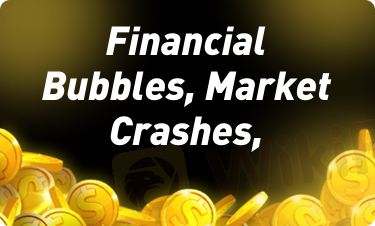
2025-02-17 18:19
IndustryFinancial Market Bubbles and Crashes
#firstdealofthenewyearastylz
Financial Market Bubbles and Crashes
A financial market bubble occurs when asset prices rise significantly above their intrinsic value due to excessive speculation, investor overconfidence, and herd behavior. Eventually, when the overvaluation is no longer sustainable, the bubble bursts, leading to a market crash—a rapid and often severe decline in asset prices.
Causes of Financial Bubbles
1. Excess Liquidity – Low interest rates and easy access to credit can inflate asset prices.
2. Speculation & Herd Mentality – Investors buy assets purely based on rising prices, not fundamentals.
3. Overconfidence & Irrational Exuberance – Investors ignore risks and believe prices will keep rising.
4. Leverage & Margin Trading – Borrowing money to invest amplifies gains but also magnifies losses.
5. Technological or Economic Innovations – New industries (e.g., dot-com boom) attract speculative investments.
Notable Financial Bubbles in History
1. Tulip Mania (1630s, Netherlands) – Tulip bulbs were traded at absurd prices before crashing.
2. South Sea Bubble (1720, UK) – Stock prices of the South Sea Company surged due to speculation and collapsed.
3. 1929 Stock Market Crash – Excessive speculation in stocks led to the Great Depression.
4. Dot-Com Bubble (1999-2000) – Internet company stocks soared irrationally before collapsing.
5. 2008 Financial Crisis – A housing bubble fueled by subprime mortgages burst, leading to a global recession.
Market Crashes: Causes & Effects
A market crash is triggered when investor confidence collapses, leading to panic selling. This can result from:
Economic shocks (e.g., financial crises, wars, pandemics)
Policy changes (e.g., interest rate hikes)
Corporate failures (e.g., Lehman Brothers in 2008)
Effects of a Market Crash:
Wealth Destruction – Investors and businesses lose significant value.
Bank Failures – If financial institutions are exposed, they may collapse.
Unemployment – Economic downturns often follow, leading to job losses.
Government Interventions – Bailouts, stimulus packages, and policy changes may be necessary.
Lessons from Market Bubbles & Crashes
Diversification reduces risk.
Avoid speculation and excessive leverage.
Understand fundamental value rather than following hype.
Monitor interest rates and economic indicators.
Be prepared for market corrections; they are inevitable.
Like 0

Ojomary
중개인
Hot content
Industry
Event-A comment a day,Keep rewards worthy up to$27
Industry
Nigeria Event Giveaway-Win₦5000 Mobilephone Credit
Industry
Nigeria Event Giveaway-Win ₦2500 MobilePhoneCredit
Industry
South Africa Event-Come&Win 240ZAR Phone Credit
Industry
Nigeria Event-Discuss Forex&Win2500NGN PhoneCredit
Industry
[Nigeria Event]Discuss&win 2500 Naira Phone Credit
Forum category

Platform

Exhibition

Agent

Recruitment

EA

Industry

Market

Index
Financial Market Bubbles and Crashes
 Hong Kong | 2025-02-17 18:19
Hong Kong | 2025-02-17 18:19#firstdealofthenewyearastylz
Financial Market Bubbles and Crashes
A financial market bubble occurs when asset prices rise significantly above their intrinsic value due to excessive speculation, investor overconfidence, and herd behavior. Eventually, when the overvaluation is no longer sustainable, the bubble bursts, leading to a market crash—a rapid and often severe decline in asset prices.
Causes of Financial Bubbles
1. Excess Liquidity – Low interest rates and easy access to credit can inflate asset prices.
2. Speculation & Herd Mentality – Investors buy assets purely based on rising prices, not fundamentals.
3. Overconfidence & Irrational Exuberance – Investors ignore risks and believe prices will keep rising.
4. Leverage & Margin Trading – Borrowing money to invest amplifies gains but also magnifies losses.
5. Technological or Economic Innovations – New industries (e.g., dot-com boom) attract speculative investments.
Notable Financial Bubbles in History
1. Tulip Mania (1630s, Netherlands) – Tulip bulbs were traded at absurd prices before crashing.
2. South Sea Bubble (1720, UK) – Stock prices of the South Sea Company surged due to speculation and collapsed.
3. 1929 Stock Market Crash – Excessive speculation in stocks led to the Great Depression.
4. Dot-Com Bubble (1999-2000) – Internet company stocks soared irrationally before collapsing.
5. 2008 Financial Crisis – A housing bubble fueled by subprime mortgages burst, leading to a global recession.
Market Crashes: Causes & Effects
A market crash is triggered when investor confidence collapses, leading to panic selling. This can result from:
Economic shocks (e.g., financial crises, wars, pandemics)
Policy changes (e.g., interest rate hikes)
Corporate failures (e.g., Lehman Brothers in 2008)
Effects of a Market Crash:
Wealth Destruction – Investors and businesses lose significant value.
Bank Failures – If financial institutions are exposed, they may collapse.
Unemployment – Economic downturns often follow, leading to job losses.
Government Interventions – Bailouts, stimulus packages, and policy changes may be necessary.
Lessons from Market Bubbles & Crashes
Diversification reduces risk.
Avoid speculation and excessive leverage.
Understand fundamental value rather than following hype.
Monitor interest rates and economic indicators.
Be prepared for market corrections; they are inevitable.
Like 0
I want to comment, too
Submit
0Comments

There is no comment yet. Make the first one.

Submit
There is no comment yet. Make the first one.